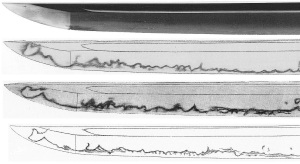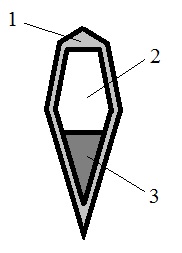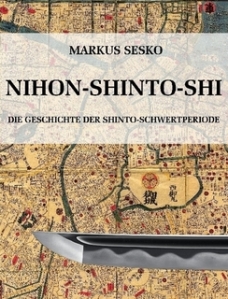In my first volume „Legends and Stories around the Japanese Sword“ I have elaborated on the famous sword „Kokindenju-Yukihira“ (古今伝授行平). To recapitulate: Shortly before the Battle of Sekigahara, Hosokawa Yûsai Fujitaka (細川幽斎藤孝, 1534-1610) held with about 500 men Tanabe Castle (田辺) in Tango province for the Tokugawa. When Ishida Mitsunari (石田三成, 1560-1600) deployed for the final move against Ieyasu, he layed siege to Tanabe with 15.000 men. Now Yûsai was less frightened of losing the castle or his live than the transmission of the anthology „Kokin-waka-shû“ (古今和歌集). It was tried two times to talk Yûsai into surrendering because everybody realized that resistace was useless and a peaceful surrending of the castle the best way. But Yūsai was stubborn. The court definitely expected the death of Yûsai and because they did not want the loss of his „kokin-denju“ (古今伝授, more on that later), they officially issued an imperial order to hand out all the documents. Thus an envoy was sent to Tanabe which consisted of the aristocrats Sanjônishi Saneeda (三条西実条, 1575-1640), Nakanoin Michikatsu (中院通勝, 1556-1610), and Karasumaru Mitsuhiro (烏丸光広, 1579-1638), who were famous poets themselves. Yûsai obeyed and surrended the castle two days before the Battle of Sekigahara after being besieged for two months. In the end Yûsai was relieved too that his kokin-denju kowledge of the „Kokin-waka-shû“ was in safe hands and presented for good measure Mitsuhiro with his beloved tachi of Yukihira which got thereupon the nickname „Kokindenju-Yukihira“.
Picture 1: kokuhô „Kokindenju-Yukihira“, mei: „Bungo no Kuni Yukihira saku“ (豊後国行平作), nagasa 79,9 cm, sori 2,9 cm; below the koshirae to the blade which is said to go back to the time of Hosokawa Yûsai.
So far the circumstances about the surrender of Tanabe Castle and the origins of the nickname of the sword. In this article I want to explain why Yûsai was so anxious about knowing the kokin-denju in safe and first and foremost in the right hands. To understand his concerns we have to go back in time. The „Kokin-waka-shû“, or short „Kokin-shû“, is an imperial anthology of Japanese waka poetry from the Heian period, or to be more precise from the early 10th century. The important thing was that it was compiled at imperial request and that it contains Japanese poetry. With this, the court started to move away from the then prevailing Chinese culture. The anthology contains more than 1.000 poems, depending on the textual transmission. Already towards the end of the Heian period it became custom to discuss on readings and hidden meanings of the poems whereas interpretations were also often kept secret by a certain school of poetry. With the Kamakura period the court entrusted the conservative aristocratic Nijô family (二条) of poetry with the transmission of the „Kokin-waka-shû“. However, the Nijô family itself split up into the Kyôgoku (京極) and Reizei (冷泉) branches which became the strongest rivals of the Nijô main line teachings of poetry. Simplifying, the transmission, the denju (伝授) of the „Kokin-waka-shû“, became a major issue of all these branches stressing their exegesis being the only one which understands all the deep meanings and nuances of the poems.
Sometime in the early Nanbokuchô era, the then Nijô head transmitted the „Kokin-waka-shû“ secrets to the poet Nikaidô Sadamune (二階堂貞宗, 1289-1372), better known under his monk name „Ton´a“ (頓阿). Ton´a in turn was a descendant of the Fujiwara-regent Morozane (藤原師実, 1042-1101). Via Ton´a and his students, the Nijô-transmission reached eventually the military leader and passionate poet Tô Tsuneyori (東常縁, 1401~1484). Tsuneyori was namely a distant descendant of the famous poet Fujiwara no Teika (藤原定家, 1162-1241) and transmitted the „Kokin-waka-shû“ to important figures of his time like shôgun Ashikaga Yoshihisa (足利義尚, 1465-1489). It has to be mentioned that the „Kokin-waka-shû“ and its secret comments transmitted orally and written via the denju ceremony was still deeply interwoven with aristocracy. But the transmission to a military leader like Tsuneyori shows the changes of times, namely the rise of the buke warrior aristocracy into the highest circles of culture. Another person Tsuneyori honoured with the transmission of the „Kokin-waka-shû“ was the monk and poet Sôgi (宗祇, 1421-1502). This denju took place in the year 1471. But with Sôgi, the secret teachings again split up. He initiated namely the aristocrat Sanjônishi Sanetaka (三条西実隆, 1455-1537) and the poet Shôhaku (肖柏, 1443-1527). Well, Shôhaku in turn initiated later when he had moved to Sakai the wealthy merchant Hayashi Sôji (林宗二, 1498-1581). This was contrary to the attitude of the aristocrats and terms like „palace transmission“ (gosho-denju, 御所伝授) and „Sakai transmission“ (Sakai-denju, 堺伝授) were introduced.
Now we come back to Yûsai. The then holder of the secret denju of the Sanjônishi family was Saneeda (三条西実枝, 1511-1579), the grandfather of the aforementioned Saneeda (三条西実条). When it was time for the former Saneeda to initiate his heir, his oldest son Kinkuni (三条西公国, 1556-1588), the latter was too young and so he transmitted the teachings to his waka student Hosokawa Yûsai. But on the very day of the initiation, the course for Yûsai´s later reaction when Tanabe was besieged was set. Yûsai swore namely: „I will not pass on these denju secrets to any other person and I take the full personal responsibility for preserving the teachings of the Sanjônishi family!“ However, he eventually broke the first promise when he later initiated the poet Matsunaga Teitoku (松永貞徳, 1571-1654). It was a great honor for the bushi Yûsai to receive a „palace transmission“ from Sanjônichi Saneeda and with this he was able to trace back his line of poetry to the Nijô family, namely in an official sense, which made him a great authority in poetry of his time. Well, we know the outcome of the siege and Yûsai initiated apart from Kinkuni´s son Saneeda also prince Hachijōnomiya Toshihito (八条宮智仁, 1579-1629), the younger brother of the then emperor Go-Yôsei (後陽成, 1571-1617). And when Toshihito later initiated emperor Go-Mizunoo (後水尾天皇, 1596-1680) in the year 1625, the latter decided that the aristocratic „palace transmission“ of the Sanjônishi family should henceforth only be transmitted from emperor to emperor.
Picture 2: Letter of Hosokawa Yûsai confirming his transmission of the Sanjônishi line of the kokin-denju to prince Toshihito on the 29th day of the seventh month Keichô five (慶長, 1600).
Well, Go-Mizunoo made some exceptions. For example he initiated the poet Asukai Massaki (飛鳥井雅章, 1611-1679) and this initiation is of special interest as the aristocrat Takatsukasa Kanehiro (鷹司兼煕, 1660-1725) made later a drawing of it, that means the altar erected for the ceremony (see picture 3). On top we see a portrait of the famous poet and aristocrat Kakinomoto Hitomaro (柿本人麻呂, 662-710) as object of veneration who is mentioned in the preface of the „Kokin-waka-shû“ as „divine poet“. We see salt, a mirror, a sword and other things which show us that the kokin-denju had become a kind of religious ceremony placing emphasis on the mystical and secret nature of the teachings. So Yûsai was not only trying to preserve just a collection of old poems but a system of aristocratic transmission which when being lost meant the loss of centuries of forming and growing of Japanese poetry and culture. And he was well aware of his role…
Picture 3: Drawing of Takatsukasa Kanehiro of the altar used during the kokin-denju ceremony.
For more details on the „Kokin-waka-shû“ see also Anne Commons, Hitomaro: Poet as God, Brill Academic Pub 2009
























